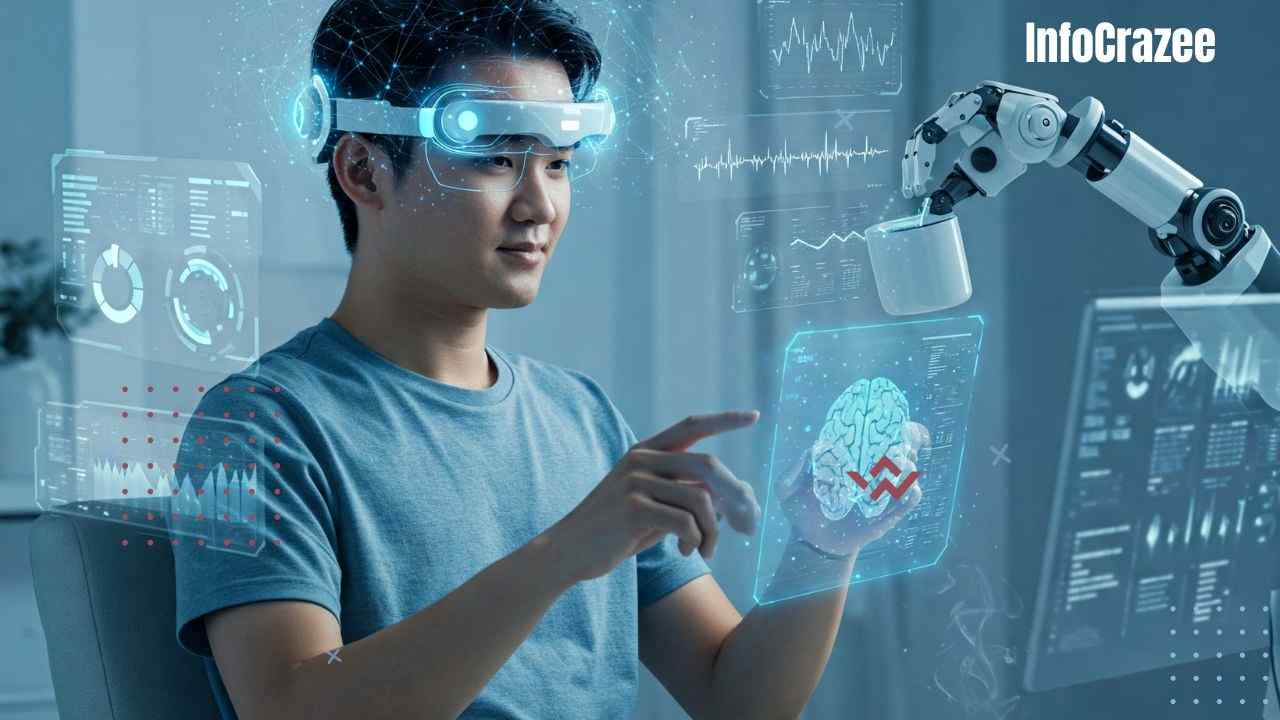Brain-Computer Interfaces: How Our Minds Could Soon Control Technology
Imagine sending a text, turning off the lights, or even playing a video game—just by thinking about it. Sounds like sci-fi, right? Well, it’s quickly becoming a reality thanks to something called Brain-Computer Interfaces or BCIs.
At Infocrazee, we love exploring how technology is shaping our lives, and BCIs are one of the most exciting breakthroughs out there. Let’s break down what BCIs are, how they work, what they can do, and how they might soon change everything—from healthcare to how we play games.
So, What Exactly Is a Brain-Computer Interface?
A Brain-Computer Interface is a system that allows your brain to communicate directly with a computer or device—without needing to use your hands, voice, or any physical movement.
In simple terms:
Your brain gives the command → the computer picks it up → the device reacts.
It’s like giving your brain a Wi-Fi connection to the digital world.
How Do BCIs Actually Work?
Let’s keep it simple.
Our brains send out electrical signals all the time—to move our hands, speak, even to dream. BCIs use sensors to pick up these signals and turn them into actions.
There are a few key parts involved:
- Sensors or electrodes: These sit on your head (or sometimes even inside your brain) to detect brain activity.
- A computer or processing unit: This decodes the signals and figures out what you want to do.
- An output device: This could be a robotic arm, a smartphone, or a computer cursor that carries out your “mental” command.
It’s kind of like your brain sending a message in Morse code—and the computer translating it instantly.
Real-World Examples That Sound Like Magic
BCIs aren’t just lab experiments anymore. Here are some amazing things already happening:

1. Helping People with Disabilities
- Paralyzed patients can move robotic limbs or wheelchairs using only their thoughts.
- Some people who can’t speak due to conditions like ALS are using BCIs to type messages using brain signals.
2. Gaming and Entertainment
- Companies like Neuralink and NextMind are testing BCI headsets that let you control video games with your mind. Imagine aiming or jumping in a game without lifting a finger!
3. Medical Monitoring
- BCIs can detect early signs of epileptic seizures, stress, or sleep disorders, giving doctors a way to help before things get worse.
The Tech Behind the Magic
Let’s nerd out for a second (just a little!).
BCIs come in two main types:
- Non-invasive BCIs: These use sensors on your scalp (like EEG caps). They’re safe, easy to use, and more common—but not as accurate.
- Invasive BCIs: These involve tiny devices implanted into the brain. They’re more powerful and precise but come with higher risks, like infection or brain damage.
Many companies are working to improve non-invasive BCIs so they can be used at home or in everyday life.
What’s Coming Next?
Here’s a sneak peek into what BCIs might help us do in the near future:

- Type or text just by thinking
- Control smart homes—lights, locks, thermostats—without lifting a finger
- Play music or change TV channels with your thoughts
- Interact in virtual reality in totally new ways
And in the long run? Some scientists believe we might one day be able to “upload” memories, enhance intelligence, or treat mental health issues directly through brain interfaces.
Should We Be Excited or Worried?
It’s okay to feel both.
Here are a few amazing benefits:
- Empowering people with disabilities
- Creating faster and more natural ways to use tech
- Offering new tools for learning, therapy, and creativity
But there are also some serious concerns:
- Privacy: Could companies “read” your thoughts?
- Security: What if someone hacks a BCI?
- Ethics: Should we even be merging tech with the human brain this way?
These are big questions we need to answer as the tech continues to grow.
A Quick Story to Wrap Things Up
Let’s talk about Matthew, a man who was paralyzed from the neck down after a car accident. For years, he relied on others for almost everything. But thanks to a BCI system, he was able to control a robotic arm just by thinking about it. He even shook hands with his doctor—a moment he thought would never come again.
That’s the kind of real-world magic BCIs can bring.
What You Can Do Right Now
Interested in this space? Here are a few fun things to try:
- Explore brain-training apps like FocusCalm or NeuroSky
- Try out brain-controlled toys or games (some are surprisingly affordable!)
- Follow BCI companies like Neuralink, Synchron, or OpenBCI to stay in the loop
Final Thoughts
Brain-Computer Interfaces are opening the door to a future where our thoughts aren’t just ideas—they’re actions. Whether you’re dreaming of telepathy-style texting or helping someone walk again, BCIs are bringing us one step closer to that sci-fi world we’ve always imagined.
But like all powerful tools, they come with responsibility. It’s up to all of us—researchers, users, and curious folks like you—to make sure we use this tech wisely.
FAQs
1. Are brain-computer interfaces safe to use?
Yes, especially non-invasive ones. They just read brain signals from outside your head—no surgery involved. Invasive BCIs (implanted in the brain) carry more risks and are mostly used in medical settings for now.
2. Can BCIs read my thoughts or spy on me?
Not exactly. BCIs can detect patterns in brain signals related to specific actions, like moving a hand or focusing on a screen. But they can’t “read your mind” or access your private thoughts.
3. When will brain-computer interfaces be available for regular use?
Some basic versions already exist, especially in gaming and medical devices. But fully mind-controlled computers or smart homes are still a few years away from being common.






